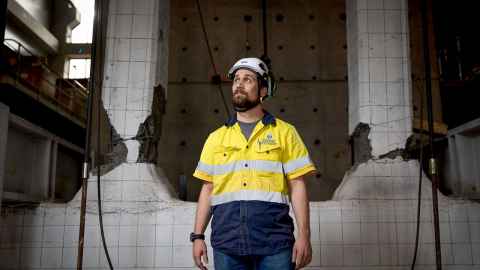Seismic testing of old bridge provides stunning results
12 December 2023
Testing the seismic stability of an 84-year-old bridge has revealed impressive resilience, providing hope for the durability of New Zealand's ageing infrastructure.

Extreme laboratory testing on an 84-year-old bridge at the University of Auckland has provided promising insights for key infrastructure across New Zealand.
“We beat the snot out of it, well beyond the displacement we would expect in a large earthquake, and the structures performed extremely well,” says lead researcher Dr Lucas Hogan from the Faculty of Engineering.
Funded by Toka Tū Ake EQC and QuakeCoRE, the researchers tested the concrete bridge piers from the deconstructed Whirokono bridge on State Highway 1 south of Foxton, which was replaced in 2020 by a wider structure over the Manawatū River and Moutoa floodplain by Waka Kotahi
The first part of the research project, in 2020, conducted seismic testing on the bridge foundation piles in their original location during the deconstruction phase in what Dr Hogan described as an “unprecedented opportunity for real-life testing on a long bridge”.
The project team transported three of the bridge piers to the University of Auckland where they tested the concrete well beyond what could be expected in a significant earthquake.
“The results are really important because these bridges were built by the Ministry of Works in the 1930s across braided rivers around New Zealand, when they didn’t know much about seismic risks, and our testing shows that even with 80+ years of being exposed to the elements, they have plenty of strength,” says Dr Hogan.
He adds that understanding the resilience of these old bridges is important for decision-makers and planning for earthquake response.
“We have seen how disruptive the closure of one of these bridges can be for communities, for example when the Ashburton bridge subsided last year, and drivers had to take a six-hour detour.”
Dr Hogan says that the Ashburton scenario will be multiplied in an Alpine Fault event, “but it is encouraging to know that these old bridges are still up for the job, for the next few years at least”.
Toka Tū Ake EQC Chief Resilience and Research Officer Dr Jo Horrocks says that it is incredible rewarding for the natural hazard agency to see their research investment deliver such major benefits for New Zealanders and their infrastructure.
“One of the most key areas where we can reduce the impact of natural hazards is to increase the resilience of our infrastructure. When bridges and roads are unpassable, any recovery will be significantly affected, as we saw in Kaikōura in 2016,” says Dr Horrocks.
Looking beyond the positive test results, the research team is now exploring retrofit solutions to enhance the longevity and resilience of the old bridges by testing these techniques on the remaining column from the Whirokino Bridge.
Dr Hogan explains how a chance meeting with colleague Santiago Pujol revealed a raft of retrofit techniques the University of Canterbury engineer had developed based on previous research in Japan in the 1980s.
“They had developed affordable solutions, using steel rods and clamps, to strengthen these old 1930s bridges, so they can last a bit longer or when we need to repair any minor damage after an earthquake,” says the researcher.
Dr Hogan says that his team had been incredibly lucky to be part of a “once-in-a-lifetime” project he hopes will help inform infrastructure decisions for many years to come.
Media contact
Hussein Moses | Media adviser
M: 027 361 1000
E: hussein.moses@auckland.ac.nz